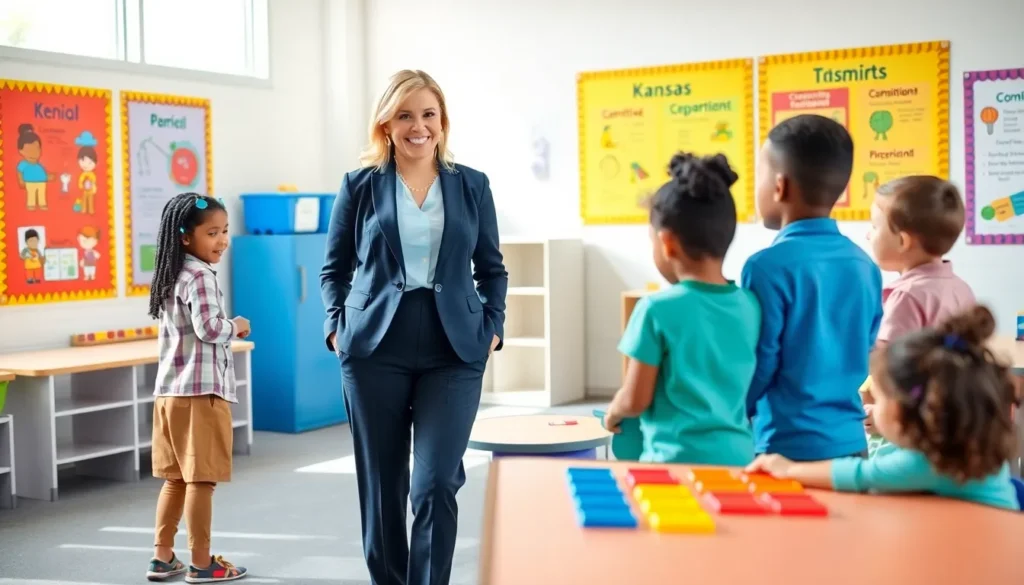In a world where the only thing more confusing than your last trip to IKEA is navigating early childhood education, Kansas has stepped up with its Early Learning Standards. These guidelines are like GPS for educators, helping them chart a course through the developmental milestones of young learners. So, whether you’re an educator looking to enrich your classroom experience or a parent eager to understand what’s coming next for your little one, let’s jump into what these standards really mean. Spoiler: They’re more exciting than they sound.
Table of Contents
ToggleOverview of Kansas Early Learning Standards

The Kansas Early Learning Standards serve as a foundational framework for the state’s early childhood education system. Created to provide educators and caregivers with clear expectations, these standards outline the skills and knowledge children should have as they approach school readiness. They reflect best practices in early education and emphasize a holistic approach to child development, ensuring that all areas of growth are addressed in a child’s formative years.
Purpose and Importance of the Standards
The primary purpose of the Kansas Early Learning Standards is to promote positive developmental outcomes for children from birth to age eight. These standards are crucial for several reasons:
- Guidance for Educators: They provide educators with a roadmap for planning and implementing developmentally appropriate practices.
- Supporting Families: Families gain insights into the educational milestones their children should reach, fostering engagement and involvement.
- Quality Assurance: Establishing a set of standards ensures quality and consistency across early childhood programs in Kansas.
- Policy Development: These standards inform policies and funding decisions, fostering improvements in the education system.
Key Components of the Kansas Early Learning Standards
The Kansas Early Learning Standards encompass multiple domains that are integral to a child’s development:
Domains of Development and Learning
These domains shape the overall structure of the standards, highlighting the diverse areas in which children grow and learn.
Social and Emotional Development
This component addresses children’s ability to form healthy relationships, express feelings, and develop self-regulation, which are pivotal for their emotional well-being.
Cognitive Development
Cognitive skills such as thinking, reasoning, problem-solving, and understanding concepts are emphasized, enabling children to make sense of their world.
Physical Development and Health
Here, the focus is on gross and fine motor skills as well as overall health. This includes promoting physical activity and healthy habits, which are fundamental to children’s growth.
Language and Literacy Development
Children learn to communicate verbally and non-verbally, as well as develop early literacy skills. This ensures they have a strong foundation for reading and writing in the future.
Implementation Strategies for Educators
To effectively incorporate the Kansas Early Learning Standards, educators can employ several strategies:
- Professional Development: Ongoing training for educators is essential for staying updated on best practices and understanding the standards deeply.
- Collaborative Planning: Working collaboratively with colleagues helps share insights and resources, fostering a cohesive approach across the curriculum.
- Family Engagement: Educators can engage families in their children’s learning processes through workshops, newsletters, and activities that coincide with the standards.
- Play-Based Learning: Emphasizing play in the learning environment allows children to explore and apply learning in a natural manner.
Assessment and Evaluation Practices
Effective assessment practices are critical for understanding how well children are meeting the Kansas Early Learning Standards. Some recommended approaches include:
- Ongoing Observations: Regular, informal observations help educators assess children’s progress in real time.
- Developmental Checklists: Utilizing checklists aligned with the standards aids in tracking growth across different domains.
- Portfolios: Maintaining individual portfolios allows educators and families to see a child’s journey and development over time.
- Family Participation: Involving families in the evaluation process encourages a shared understanding of a child’s progress and areas for improvement.
Resources and Support for Educators and Families
For those navigating the Kansas Early Learning Standards, various resources are available:
- Kansas Department of Education: Offers training, workshops, and materials tailored for educators.
- Online Platforms: Websites and forums where educators can find lesson plans, share experiences, and access professional development.
- Local Education Agencies: They often provide regional support, resources, and workshops for families and educators.
- Community Programs: Many communities offer programs that align with early learning standards and support family involvement.







